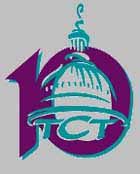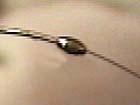| Interview Martin B. Leon, M.D., Part II |
||
| |
|
|
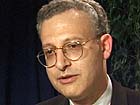
|
Martin
B. Leon, M.D. is Director of Cardiovascular Research and Education
for the Cardiology Research Foundation and Course Director for the
annual Transcatheter Cardiovascular Therapeutics (TCT), the most widely
attended interventional meeting in the world. |
|
|
In
Part I of our interview, Dr. Leon discussed
the concept of teaching interventional techniques via live case
demonstrations. In 1978, Andreas Gruentzig held the first live demonstration
course, utilizing closed-circuit TV to send the cases from one room
to another down the hall. Today the TCT features satellite transmissions
of live cases from around the world. |
||
| Q: Can you give us a brief summary of the various stages of device development in interventional cardiology. |
||
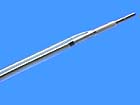 early balloon catheter |
Leon:
Sure. I think that the era of angioplasty over the last twenty years
has been highlighted by the initial phase, of course, of sole balloon
angioplasty, between 1977 and 1988. |
|
| Then
we had an interesting five year period of what I'll describe as new
device angioplasty, where we were frustrated by some of the limitations
of polyethylene balloon barotrauma as a technique, and we took a whole
series of new devices, lasers, atherectomy devices and stents, into
clinical practice. |
|
|
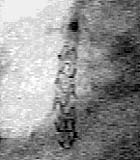 fluoroscopic view of stent being placed in artery |
I
think we learned that some of these are effective, some are not so
effective, but we did at that time become exposed to the use of stents,
and since 1993 we've emerged from that curious observational period
of new device angioplasty, into this era of "stent-frenzy", where
we've now become clearly consumed, perhaps overly so, with the use
of stents as being the major treatment modality in coronary disease.
|
|
| So
there has been truly a paradigm shift. Whereas a decade ago, any interventionalist
would want to put a balloon in pretty much any lesion in the coronaries,
now, and in the future, until something supplants stents, what I see
happening is that we'll use balloons before stents or after stents,
to achieve an optimal result, but the goal will be, from the standpoint
of predictability, and acute and late outcomes, to be able to use
stents as frequently as we can in the most appropriate clinical circumstances.
And I think we'll continue to see an evolution beyond this. I certainly
do not believe that the future of interventional cardiology will be
based solely on the application of a bare metal prosthesis on a vascular
surface. |
||
| Q:
What does the future hold? Leon: I think that stents have been the greatest single breakthrough in interventional cardiology since the advent of the balloon. But I view stents as a foundation or platform to try to alter local vascular biology, so adjunctive therapy with stents will become very, very important. Among those certainly there is pharmacotherapy and new drugs being tried and integrated all the time. I also think that the concept of TMR or PTMR (percutaneous transmyocardial revascularization -- sometimes called PMR, ed.) may also add tremendous functional advantage in patients that have ischemia and totally obstructed vessels. And we're very excited about radiation. We think radiation is going to have an important role: stent-based, beta, gamma, catheter-based, guide wire-based, there are many different iterations. And there is now certainly 2-5 years of work to understand how to sort all this out. But the early message is, it looks like radiation works, looks like there's a good chance we'll be able to reduce restenosis rates within stents predictably amongst a wide spectrum of patient cohorts to less than 10%. |
||
| If
we can achieve that, then what it does is change the whole treatment
paradigm, from my perspective. What it does is tell us that no one
can ever say that coronary intervention, angioplasty, in the generic
sense, is a non-definite technique. |
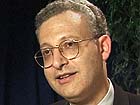
|
|
| It
becomes as durable and as definite as bypass surgery, which was Andreas'
original dream and which has been our obsession since the early eighties.
And the evolution of new technology makes me believe that either at,
or soon after, the next millenium that we'll achieve that. |
||
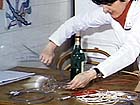 early balloon catheters being assembled on kitchen table in Zurich |
Q:
Speaking of technology and the future, what about medical device development?
Only twenty years ago, the original angioplasty balloon prototypes
were fabricated on a kitchen table in Zurich....? Leon: I believe the era of gluing components together on the kitchen table or developing this wonderful new technique in your garage or in your basement is gone. |
|
| I
think that the era of new advanced technology development is going
to be with Silicon Graphics workstations, and bright young kids who
work in wonderful environments that can flourish creative spirit with
a lot of support. And I think that there's going to be a real shift
from the crude prototype concept to a far more esoteric, yet "made
simple" concept, with a different kind of individual with a different
but updated 21st century creative spirit. Q: What advice do you have for somebody entering the field today? |
||
| Leon:
I think that there's no substitute for physician-patient skills in
coronary intervention, that being a compassionate physician will always
be the most important component of being a good interventionalist.
At the same time, I think you have to be patient and have a great
deal of experience in order to do this procedure correctly. And I
think that one of the frustrations I have is that many of the young
interventionalists are a little too impatient to develop their skills
over time. It literally takes years. It's terribly important for them
to participate in the academic process.
|
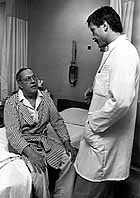 inventor of PTCA, with a patient |
|
| We need to continue to understand what we're doing, not simply to do clinical intervention in the abstract, but rather to participate in the whole process of evolving the field of interventional cardiology. |
||
This
concludes our interview with Dr. Leon. In coming weeks, our series
of exclusive interviews with angioplasty pioneers and leaders will
continue with Fayaz Shawl, MD, Richard Myler, MD, Patrick Serruys,
MD, Bernhard Meier, MD and many more. 
|
||
| |
||
|
Angioplasty.Org Home • PatientCenter send comments & suggestions
to "info at angioplasty dot org" |
||
